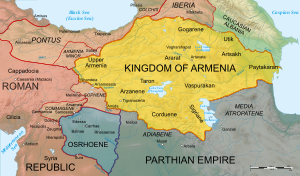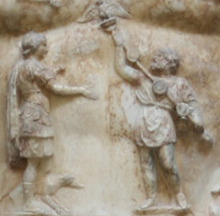Phraates IV
| Phraates IV 𐭐𐭓𐭇𐭕 | |
|---|---|
Arsacid dynasty | |
| Father | Orodes II |
| Religion | Zoroastrianism |
Phraates IV (also spelled Frahad IV;
Phraates IV
Around the same time, Phraates IV's throne was usurped by Tiridates II, but he quickly managed to reestablish his rule with the aid of Scythian nomads. Tiridates fled to the Romans, taking one of Phraates IV's sons with him. In negotiations conducted in 20 BC, Phraates IV arranged for the release of his kidnapped son. In return, the Romans received the lost legionary standards taken at Carrhae in 53 BC, as well as any surviving prisoners of war. The Parthians viewed this exchange as a small price to pay to regain the prince.
Along with the prince, Octavian (now known as Augustus) gave Phraates IV an Italian slave-girl named Musa, who quickly became queen and a favourite of Phraates IV, giving birth to Phraataces (Phraates V). Seeking to secure the throne for her son, Musa convinced Phraates IV to send his four first-born sons (Vonones, Phraates, Seraspandes and Rhodaspes) to Rome in order to prevent conflict over his succession. In 2 BC, Musa had Phraates IV poisoned and made herself along with Phraates V the co-rulers of the empire.
Name
Phraátēs (Φραάτης) is the
Consolidation of power
In 38 BC, the heir to the Parthian throne,

Phraates IV also had supporters of his brothers and his own opponents sent into exile; one of them,
War with Mark Antony

The following year, when Antony marched to
The defeat of Antony, along with that of Crassus at
Brief overthrow, diplomatic correspondence with Augustus and death

Following the defeat of Antony and
Along with the prince, Augustus gave Phraates IV an Italian slave-girl named Musa, who quickly became queen and a favourite of Phraates IV, giving birth to Phraataces (Phraates V).[24] Emma Strugnell (2008) has suggested that Augustus' choice to send Musa may have been an attempt to obtain information or influence the Parthian king to the advantage of the Romans.[25] She further adds that "Augustus could potentially launch a punitive invasion against Parthia, with the probable aim of converting it into a Roman province."[26] According to the Parchments of Avroman, Phraates IV had already at least four other queens at that time: Olennieire, Cleopatra, Baseirta and Bistheibanaps.[27]
Seeking to secure the throne for her son, Musa convinced Phraates IV in 10/9 BC to send his four first-born sons (Vonones, Phraates, Seraspandes and Rhodaspes) to Rome in order to prevent conflict over his succession.[28] Again, Augustus used this as propaganda depicting the submission of Parthia to Rome, listing it as a great accomplishment in his Res Gestae Divi Augusti.[29] In 2 BC, Musa had the aged Phraates IV poisoned and made herself along with Phraates V the co-rulers of the empire.[30]
Coinage

Under Phraates IV and his father, the production of coins reached its zenith, with the only Parthian ruler having similar numbers being Mithridates II (r. 124–88 BC).[31] Phraates IV mostly kept the same style of Parthian coinage that was used under his father.[32] The obverse of his coins portrays him with short hair and beard, along with a visible moustache.[32] According to the modern historian Vesta Sarkhosh Curtis, the portrait greatly resembles the Shami statue, discovered in the Bakhtiari mountains in southwestern Iran, and currently stored in the National Museum of Iran in Tehran.[33] A bird of prey is present behind his head, which is associated with the khvarenah, i.e. kingly glory.[34] The bird, possibly a symbol of the bird of the deity Verethragna, is holding a diadem, a wreath or a ring.[34]
The reverse depicts a seated archer wearing a soft cap (
Family
Marriages
Phraates IV had the following wives:[40]
- Olennieire
- Cleopatra
- Baseirta
- Bistheibanaps
- Musa
Issue
- Vonones I, eldest son and Parthian King from 8 to 12. Subsequently King of Armenia from 12 to 18.
- Phraates, one of his first-born sons, attempted to take the Parthian throne from Artabanus II in 35.[41]
- Seraspandes, one of his first-born sons, sent to Rome, where he remained till his death.[42]
- Rhodaspes, one of his first-born sons, sent to Rome, where he remained till his death.[42]
- Karen, the eponymous founder of the House of Karen, one of the Seven Great Houses of Iran.[43]
- Unnamed daughter, who was the wife of a Dahae prince and mother of Artabanus II.[44]
- Phraataces (Phraates V), Parthian King from 2 BC to 4 AD.[45]
References
- ^ Schmitt 2005.
- ^ Kia 2016, p. 160.
- ^ Bivar 1983, p. 58; Brosius 2006, p. 96; Kennedy 1996, pp. 80–81; see also Strugnell 2006, pp. 239, 245–246
- ^ a b c d Bivar 1983, p. 58.
- ^ Dąbrowa 2018, pp. 80–81.
- ^ Boyce & Grenet 1991, p. 313.
- ^ Russell 1987, p. 125; Bivar 1983, p. 58
- ^ a b c Cassius Dio, Book 49, 24.1.
- ^ Plutarch, vol IX. 37.1.
- ^ Russell 1987, p. 125.
- ^ Bivar 1983, pp. 58–59.
- ^ Bivar 1983, pp. 60–63; Garthwaite 2005, p. 80; Curtis 2007, p. 13; see also Kennedy 1996, p. 81 for analysis on Rome's shift of attention away from Syria to the Upper Euphrates, starting with Antony.
- ^ Bivar 1983, p. 66.
- ^ Roller 2010, p. 99
- ^ Burstein 2004, p. 31; Bivar 1983, pp. 64–65; Bivar 1983, pp. 64–65
- ^ Bivar 1983, pp. 64–65.
- ^ Widengren 1986, pp. 135–136.
- ^ Roller 2010, pp. 145–151.
- ^ Roller 2010, pp. 138–151; Bringmann 2007, pp. 304–307
- ^ Bivar 1983, pp. 65–66
- ^ Garthwaite 2005, p. 80; see also Strugnell 2006, pp. 251–252
- ^ Bivar 1983, pp. 66–67
- ^ Brosius 2006, pp. 96–97, 136–137; Bivar 1983, pp. 66–67; Curtis 2007, pp. 12–13
- ^ Kia 2016, p. 198; Schippmann 1986, pp. 525–536
- ^ Strugnell 2008, p. 283.
- ^ Bigwood 2008, p. 283.
- ^ Strugnell 2008, p. 283 (see also note 36); Bigwood 2008, pp. 244–245
- ^ Kia 2016, p. 198; Strugnell 2008, pp. 284–285; Dąbrowa 2012, p. 173; Schippmann 1986, pp. 525–536
- ^ Bivar 1983, p. 67; Brosius 2006, pp. 96–99
- ^ Kia 2016, p. 199; Richardson 2012, p. 161; Bivar 1983, p. 68
- ^ Metcalf 2016, p. 284.
- ^ a b c Rezakhani 2013, p. 771.
- ^ a b Curtis 2012, p. 71.
- ^ a b Curtis 2016, p. 184.
- ^ Curtis 2007, p. 419.
- ^ Curtis 2012, p. 76–77.
- ^ Boyce 1984, p. 82.
- ^ Curtis 2012, p. 71; Olbrycht 2016, p. 99; Curtis 2016, p. 183
- ^ Bigwood 2004, p. 60.
- ^ Brosius 2000.
- ^ Dąbrowa 2017, pp. 175–176.
- ^ a b Strugnell 2008, pp. 284–285.
- ^ Pourshariati 2017.
- ^ Olbrycht 2014, pp. 94–96.
- ^ Kia 2016, p. 199; Dąbrowa 2012, p. 174
Bibliography
Ancient works
- Cassius Dio, Roman History
- Plutarch, Parallel Lives
Modern works
- Bivar, A.D.H. (1983). "The Political History of Iran Under the Arsacids". In ISBN 0-521-20092-X.
- Bigwood, J. M. (2004). "Queen Mousa, Mother and Wife(?) of King Phraatakes of Parthia: A Re-evaluation of the Evidence". Journal of the Classical Association of Canada. 4 (1). Project Muse: 35–70. S2CID 164436127.
- Bigwood, Joan M. (2008). "Some Parthian Queens in Greek and Babylonian Documents". Iranica Antiqua. 43: 235–274. .
- ISBN 9780415239028.
- Boyce, Mary; Grenet, Frantz (1991). Beck, Roger (ed.). A History of Zoroastrianism, Zoroastrianism under Macedonian and Roman Rule. Leiden: Brill. ISBN 978-9004293915.
- Brosius, Maria (2000). "Women i. In Pre-Islamic Persia". Encyclopædia Iranica, online edition. New York.
{{cite encyclopedia}}: CS1 maint: location missing publisher (link) - Brosius, Maria (2006), The Persians: An Introduction, London & New York: Routledge, ISBN 978-0-415-32089-4
- Bringmann, Klaus (2007) [2002]. A History of the Roman Republic. Translated by W. J. Smyth. Cambridge: Polity Press. ISBN 978-0-7456-3371-8.
- Burstein, Stanley M. (2004), The Reign of Cleopatra, Westport, CT: Greenwood Press, ISBN 978-0-313-32527-4.
- Curtis, Vesta Sarkhosh (2007). "Religious Iconography on Ancient Iranian coins". Journal of Late Antiquity. London: 413–434.
- Curtis, Vesta Sarkhosh (2012). "Parthian Coins: Kingship and Divine Glory": 67–83.
{{cite journal}}: Cite journal requires|journal=(help) - Curtis, Vesta Sarkhosh (2016). "Ancient Iranian Motifs and Zoroastrian Iconography". In Williams, Markus; Stewart, Sarah; Hintze, Almut (eds.). The Zoroastrian Flame Exploring Religion, History and Tradition. I.B. Tauris. pp. 179–203. ISBN 9780857728159.
- Dąbrowa, Edward (2012). "The Arsacid Empire". In ISBN 978-0-19-987575-7.
- Dąbrowa, Edward (2017). "Tacitus on the Parthians": 171–189.
{{cite journal}}: Cite journal requires|journal=(help) - Dąbrowa, Edward (2018). "Arsacid Dynastic Marriages". Electrum. 25: 73–83. .
- Garthwaite, Gene Ralph (2005), The Persians, Oxford & Carlton: Blackwell Publishing, Ltd., ISBN 978-1-55786-860-2.
- Kia, Mehrdad (2016). The Persian Empire: A Historical Encyclopedia [2 volumes]. ABC-CLIO. ISBN 978-1610693912.
- ISBN 978-1-887829-18-2
- Metcalf, William E. (2016). The Oxford Handbook of Greek and Roman Coinage. Oxford: Oxford University Press. ISBN 9780199372188.
- Olbrycht, Marek Jan (2014). "The Genealogy of Artabanos II (AD 8/9–39/40), King of Parthia": 92–97.
{{cite journal}}: Cite journal requires|journal=(help) - Olbrycht, Marek Jan (2016). "Dynastic Connections in the Arsacid Empire and the Origins of the House of Sāsān". In Curtis, Vesta Sarkhosh; Pendleton, Elizabeth J.; Alram, Michael; Daryaee, Touraj (eds.). The Parthian and Early Sasanian Empires: Adaptation and Expansion. Oxbow Books. ISBN 9781785702082.
- Pourshariati, Parvaneh (2017). "Kārin". Encyclopædia Iranica, online edition. New York.
{{cite encyclopedia}}: CS1 maint: location missing publisher (link) - ISBN 978-0199733309.
- Richardson, J.S. (2012). Augustan Rome 44 BC to AD 14: The Restoration of the Republic and the Establishment of the Empire. Edinburgh University Press. ISBN 978-0-7486-1954-2.
- Roller, Duane W. (2010), Cleopatra: A Biography, Oxford: Oxford University Press, ISBN 978-0-19-536553-5.
- ISBN 978-0674968509.
- Schippmann, K. (1986). "Arsacids ii. The Arsacid Dynasty". Encyclopædia Iranica, online edition, Vol. II, Fasc. 5. pp. 525–536.
- Schmitt, Rüdiger (2005). "Personal Names, Iranian iv. Parthian Period". Encyclopædia Iranica, online edition. New York.
{{cite encyclopedia}}: CS1 maint: location missing publisher (link) - Strugnell, Emma (2006), "Ventidius' Parthian War: Rome's Forgotten Eastern Triumph", Acta Antiqua, 46 (3): 239–252,
- Strugnell, Emma (2008). "Thea Musa, Roman Queen of Parthia". Iranica Antiqua. 43: 275–298. .
- Widengren, G. (1986). "Antiochus of Commagene". Encyclopædia Iranica, online edition, Vol. II, Fasc. 2. pp. 135–136.
Further reading
- Dąbrowa, Edward (2007). "The Parthian Kingship": 123–134.
{{cite journal}}: Cite journal requires|journal=(help) - Dąbrowa, Edward (2010). "Arsakes Epiphanes. Were the Arsacids Deities "Revealed"?": 223–231.
{{cite journal}}: Cite journal requires|journal=(help) - Dąbrowa, Edward (2013). "The Parthian Aristocracy: Its Social Position and Political Activity": 53–62.
{{cite journal}}: Cite journal requires|journal=(help) - Marciak, Michał (2017). Sophene, Gordyene, and Adiabene: Three Regna Minora of Northern Mesopotamia Between East and West. BRILL. ISBN 9789004350724.
- Olbrycht, Marek Jan (1997). "Parthian King's tiara - Numismatic evidence and some aspects of Arsacid political ideology". 2: 27–61.
{{cite journal}}: Cite journal requires|journal=(help) - Olbrycht, Marek Jan (2015). "Arsacid Iran and the nomads of Central Asia – Ways of cultural transfer". Complexity of Interaction Along the Eurasian Steppe Zone in the First Millenium Ce, Edited by Jan Bemmann, Michael Schmauder (Bonn Contributions to Asian Archaeology, Volume 7) Bonn 2015 [Vor- und Fruhgeschichtliche Archäologie, Rheinische Friedrich-Wilhelms-Universität Bonn]: 333–390.
- Shayegan, M. Rahim (2011). Arsacids and Sasanians: Political Ideology in Post-Hellenistic and Late Antique Persia. Cambridge University Press. pp. 1–539. ISBN 9780521766418.
